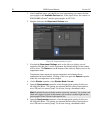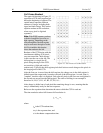
Chapter 5 Operation 57
57
Continuous Exposure (No Shuttering)
For full-frame imaging CCDs, the standard PIXIS camera for imaging is equipped with
an integral shutter. However, inasmuch as it is possible to order the camera without a
shutter, the following general discussion of unshuttered operation is provided.
Slow scan scientific cameras require a shutter to prevent "smearing" of features during
readout. This is because during readout, charge is moved horizontally or vertically across
the surface of the CCD. If light is falling on the CCD during readout then charge will
continue to accumulate, blurring the image along one direction only.
Because spectroscopy CCDs typically have their parallel shifting aligned vertically
(perpendicular to the spectrum), smearing does not affect the spectral resolution, only the
intensity level of the spectral features. When vertically binned, the readout generally
takes a few milliseconds to tens of milliseconds. In experiments where the exposure time
is much larger than the readout time, the smearing due to readout is insignificant, and the
CCD can be operated without a shutter with very little loss of performance.
If the CCD is set up for imaging mode (the WinSpec Imaging option has been installed
and is selected on the Experiment Setup|ROI Setup tab), smearing may be more of a
factor. In this case, controlling the light source so no light falls on the CCD during
readout would minimize any smearing. If the light source can be controlled electronically
via the output of the LOGIC OUT connector, the CCD can be read out in darkness.
Exposure Time
Exposure time, which is set on the Experiment Setup|Main tab {Common
Acquisition Settings expander}, is the time between start acquisition and stop
acquisition commands sent by the application software to the camera. In combination
with triggers, these commands control when continuous cleaning of the CCD stops and
when the accumulated signal will be readout. The continuous cleaning prevents buildup
of dark current and unwanted signal before the start of the exposure time. At the end of
the exposure time, the CCD is readout and cleaning starts again.
Because some PIXIS cameras do not incorporate an internal shutter, some signal may
accumulate on the array while it is being readout. This continuous exposure of the array
during readout may result in some smearing. However, exposures that are significantly
longer than the readout time can be performed without a shutter, as the amount of
smearing will be low.
If smearing or other factors require a shutter, the NOT SCAN {Not Reading Out} or the
SHUTTER {Shutter Open}signal at the LOGIC OUT connector (on the rear of the PIXIS)
can be used to control a customer-supplied external shutter. By using one of the signals to
synchronize the shutter operation with exposure, the CCD can be read out in darkness.
CCD Temperature
As stated before, lowering the temperature of the CCD
will generally enhance the quality of the acquired
signal. When WinX is the controlling software,
temperature control is done via the Detector
Temperature dialog (see Figure 23) accessed from the
Setup menu. When LightField is being used,
temperature control is done on the Sensor
expander.
Figure 23. WinX
Detector Temperature dialog


















